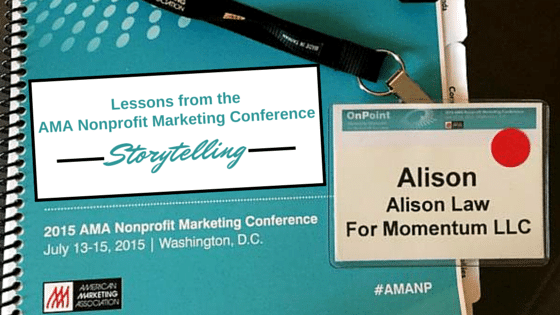 One quick programming note before I jump into today’s post: Mollye Rhea, president and founder of For Momentum, recently discussed what companies really want from nonprofit partners on Cause Talk Radio. Our 2015 survey of corporate decision-makers inspired the discussion. Listen to Mollye in conversation with fellow cause marketing pros Megan Strand and Joe Waters on Cause Talk Radio Episode 126: What Companies Really Want from a Nonprofit Partner.
One quick programming note before I jump into today’s post: Mollye Rhea, president and founder of For Momentum, recently discussed what companies really want from nonprofit partners on Cause Talk Radio. Our 2015 survey of corporate decision-makers inspired the discussion. Listen to Mollye in conversation with fellow cause marketing pros Megan Strand and Joe Waters on Cause Talk Radio Episode 126: What Companies Really Want from a Nonprofit Partner.

My brain is still buzzing from this month’s American Marketing Association (AMA) Nonprofit Marketing Conference in Washington, D.C. Kudos to the conference committee and AMA staff for putting together an event where each session surpassed the last. In fact, I’ve got so many fantastic ideas to share that we’re going to devote several posts to “Lessons from the AMA Nonprofit Marketing Conference.”
MORE THAN JUST SHARING INFORMATION
One of the overarching themes of this year’s conference was storytelling, and no one tells a better cause story than the Ad Council. Since 1942, the Ad Council has been helping nonprofit organizations and federal government agencies create memorable public service announcements (PSAs) and iconic campaign spokespeople like Smokey Bear (“Only you can prevent wildfires.”) and McGruff the Crime Dog (“Take a bite out of crime.”). In his keynote speech at the AMA Nonprofit Marketing Conference, Tony Foleno, Senior Vice President for Research at the Ad Council, listed four things to keep in mind when crafting your brand messaging.
- You are not just sharing information. You are telling a story. Don’t get so caught up in the need to provide data that you forget to tell your cause’s human story. Foleno said the one way that nonprofits can stand out in a crowded marketplace is to tell a compelling story.
- Do your homework. Know your audience. The Ad Council devotes a lot of time to research–often conducting in-person interviews with people directly affected by an issue–before they craft their messaging. Foleno said we are obligated to listen to those we are trying to reach.
- Simplify, simplify, simplify–and then simplify some more. Our attention spans are getting shorter, not longer, so keep your messages short and simple.
- Recognize the power of emotion. Foleno shared a quote from Dr. Maya Angelou to drive home this point: “I’ve learned that people will forget what you said, people will forget what you did, but people will never forget how you made them feel.”
Foleno shared a number of videos that the Ad Council has produced to illustrate his ideas. He concluded with this powerful video from the “Love Has No Labels” campaign. One quick observation from the Nonprofit Marketing Conference: if your organization is not using video storytelling, then you are missing out. Most of the presentations at the conference featured videos.
CRAFTING A “STICKY” STORY
As a fifth grader, Dara Royer and her classmates at an Oakland, California elementary school raised money to fight famine in Ethiopia. Their efforts earned them a story in the local newspaper. Now as Chief Marketing Officer of MercyCorps, Royer has a much larger mission. She helps her organization tell the stories of how it aids in short-term disaster relief and long-term recovery efforts in countries around the world.
During her presentation, Royer defined a “sticky” story as: “A memorable story you experience that imprints itself and stays in your memory, that makes you think, feel and want to act and share.” Word of mouth, whether it happens in person or via social media, is still an important goal of any story; you want people to share the message with their friends and family. For that reason, your story has to be captivating and worth sharing.
Royer said the components of a “sticky” story take your audience on a journey, make them feel (echoing Foleno’s tip about creating stories that elicit emotion above) and then help them relate. She showed a very relatable video from Proctor & Gamble’s Always #LikeAGirl campaign as an example of a “sticky” story.
The “Like a Girl” video has received more than 58 million views on YouTube since last summer and recently won a GoodWorks Effie Award for making audiences acknowledge and rethink gender biases. Foleno and Royer both shared amazing tips and examples of impactful storytelling in the presentations. What is your organization doing to craft emotional, “sticky” stories that people remember and share?
– See more at: https://www.formomentum.com/Blog/tabid/87/PostID/252/Lessons-from-the-2015-AMA-Nonprofit-Marketing-Conference-Storytelling.aspx#sthash.QXO0Hhzp.dpuf
